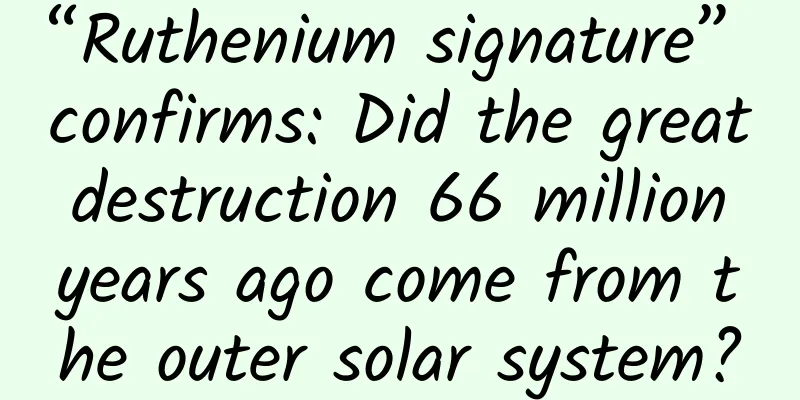“Ruthenium signature” confirms: Did the great destruction 66 million years ago come from the outer solar system?

|
For a long time, the sudden disappearance of dinosaurs on Earth has been a mystery. The scientific community has various speculations about this, mainly climate change and asteroid impact. It was not until 1980 that Nobel Prize winner in Physics Luis Alvarez and his son Walter, as well as Frank Asaro, Helen Mitchell and other scientists found that the iridium content in the strata at the junction of the Cretaceous and Paleogene periods around the world exceeded the standard, providing definite evidence for the impact theory. The asteroid impact that led to the extinction of dinosaurs in the Cretaceous period gradually became the mainstream consensus in the scientific community. So where did this asteroid that caused the extinction of dinosaurs and most of the creatures on Earth, reshuffled the composition of organisms, and rewritten the history of biological evolution on Earth come from? This is another mystery. Earlier, the scientific community believed that this asteroid came from the main asteroid belt, that is, the asteroid belt between the orbits of Mars and Jupiter. In September 2007, a scientific team led by William Potek of the Southwest Research Institute in the United States used computer modeling to calculate that the main "culprit" of the impact event was an asteroid named Baptistina (numbered 298). The asteroid has a diameter of 160 kilometers. It broke into pieces after colliding with an asteroid with a diameter of about 55 kilometers 160 million years ago. A fragment of about 10 kilometers flew to the earth and formed an impact crater with a diameter of 180 kilometers in Chicxulub, Yucatan Peninsula, Mexico. This is the reason for the extinction of dinosaurs. The result of computer analysis is more than 90%. But a study published in Science magazine on August 15 overturned this conclusion. The research team found a "ruthenium signature" after analyzing rock samples obtained from the impact site. The so-called "ruthenium signature" is the isotopic characteristics of ruthenium found in the sample. These characteristics will be different for celestial bodies from different locations in the solar system. The study found that the "culprit" that hit the earth 66 million years ago and caused the Cretaceous mass extinction did not come from the main asteroid belt, but from the outer solar system. The so-called outer solar system does not refer to the area outside the solar system, but to the area outside the orbit of Jupiter. The scientific community calls the area outside the orbit of Jupiter the outer solar system, and the area inside the orbit of Jupiter the inner solar system. "Ruthenium signature" is an important "pure feature" for analyzing and identifying celestial bodies in the solar system. Ruthenium has seven stable isotopes, and these isotopes of ruthenium play different roles in celestial bodies in different regions of the solar system. Therefore, scientists can get from different samples where these samples come from in the solar system. In the solar system, asteroids are distributed in every corner, some are near and some are far away. Currently, 98.5% of the asteroids discovered by humans are in the main asteroid belt, which is a space area between the orbits of Mars and Jupiter, about 2.17~3.64 astronomical units from the sun (1 astronomical unit is about 150 million kilometers). These asteroids belong to the inner solar system asteroids. In this area, there are more than 500,000 asteroids, and 120,437 of them have been numbered. But there are far more asteroids in the solar system than this number. At present, there are more than one million asteroids that have been confirmed by humans. Therefore, although the asteroids discovered so far are all in the main asteroid belt, there are more asteroids in farther places, that is, outside the orbit of Jupiter. The farthest planet from the sun is Neptune. Beyond Neptune's orbit, there is a Kuiper Belt, which is also a densely populated area of asteroids. There are more extremely cold icy bodies there, and the orbits of some dwarf planets such as Pluto also cross that area. At the edge of the solar system, there is an Oort Cloud Belt, where there are countless comets, estimated to be trillions of them, large and small, that surround the entire solar system. Why can the "ruthenium signature" be used as evidence to identify the region where an asteroid comes from? This is because any star is formed by molecular clouds, or by the contraction of interstellar dust, and the sun is no exception. In the early days of the formation of the solar system 4.5 billion years ago, the temperature in the inner region was too high, causing volatile substances to be unable to condense and being blown farther away by the strong solar wind. In this way, the asteroids formed in the inner region have low volatile content and become small celestial bodies rich in silicate minerals. Asteroids formed farther away contain a lot of carbon and volatile chemicals, forming "carbonaceous rock" asteroids. The isotopic characteristics of ruthenium are also more abundant in more distant asteroids due to their uneven distribution in molecular clouds. The Cretaceous/Paleogene rock samples obtained by the team from three different locations just showed this characteristic, which does not match the characteristics of asteroids from the inner solar system, but matches the characteristics of asteroids from the outer solar system. This research result supports the argument that the creator of the Chicxulub impact crater in the Yucatan Peninsula of Mexico was an asteroid from the outer solar system. Asteroid impacts are one of the biggest threats to the extinction of life on Earth, including humans. The scientific community is paying more and more attention to this issue, and a global early warning and prevention mechanism has been formed to deal with asteroid threats. One of the more important significances of this research result is to remind people not only to pay attention to the threats of asteroids in the main asteroid belt and those closer to us, but also to pay special attention to threats from the outer solar system. Such threats often come suddenly and are hard to guard against, and people suffer devastating blows when they are unprepared. 66 million years ago is a lesson for us. Some people may think that this is an exaggeration and that scientists are deliberately making a fuss. For example, some people think that the asteroid 66 million years ago only left an impact crater of 180 kilometers in the Yucatan Peninsula of Mexico. How could most of the life on Earth be destroyed when it is so large and has a circumference of 40,000 kilometers? This is another scientific question, which I will not discuss in detail today and will discuss in the next section. This is an original article from Space-Time Communication. Please respect the author’s copyright. Thank you for reading. |
Recommend
Does the TV game hall interception of CP bring birth or death?
Searching for "TV game channel revenue shari...
Community operation: 12 refined methods to promote community activity!
Community operation seems to have become a standa...
Capterra: 2024 US Technology Trends Report
A survey report from Capterra shows that by 2026,...
Xinji SEO training: Optimize each internal page as the homepage
Usually when we build a website, we just do a rou...
Is there any difference in speed? Win7/8.1/10 installation test
This time, our test was conducted using Ningmei&#...
Is it really useful for TV technology to move towards mobile 4K screens on mobile phones?
The Mobile World Congress MWC2017, which just conc...
The infected person dies within 90 days? Is the "super fungus" really coming?
Rumors Recently, the news that "Candida auri...
Apple’s App Store revenue hit a new record in 2021. How long can Apple continue to “win without doing anything”?
Apple said on Monday that it now has 745 million ...
Practical application of Internet finance: Who touched your promotion fees?
If you are attracting new customers for an Intern...
Windows 10 is best with 8GB of RAM
It is an absolute truth that more memory can impr...
GITC 2014: Great changes in the Internet era from the perspective of technology development services
[[120836]] In today's ever-changing era, pred...
Seven slices of Pinduoduo live streaming
Huang Zheng’s “Disney” is hidden in Pinduoduo’s l...
Is iOS 16 worth upgrading? Here’s a sneak peek at the main features of the official version
From the initial iOS 16 beta1 to the current beta...
Operational Promotion: What is the promotional strategy behind Alipay’s “face payment”?
To be honest, I was tricked by Alipay a few days ...
Two steps to improve your product competitiveness and avoid homogenization
Below we will analyze from two perspectives: diff...









